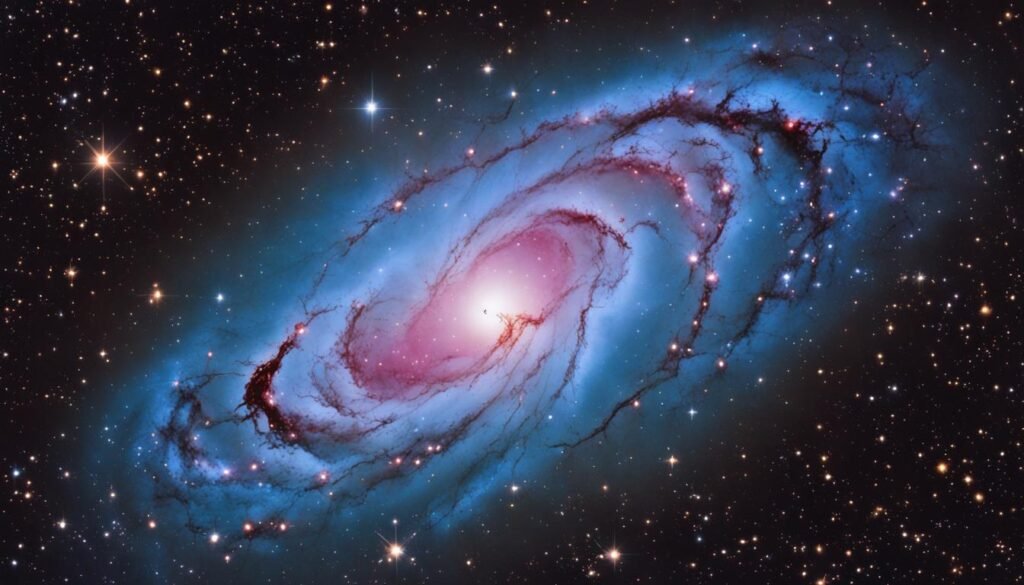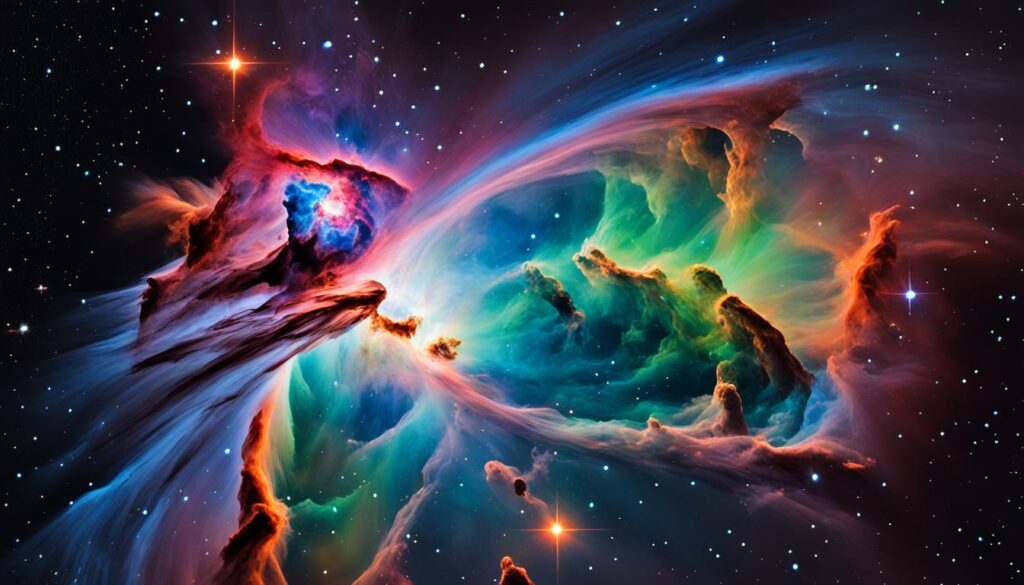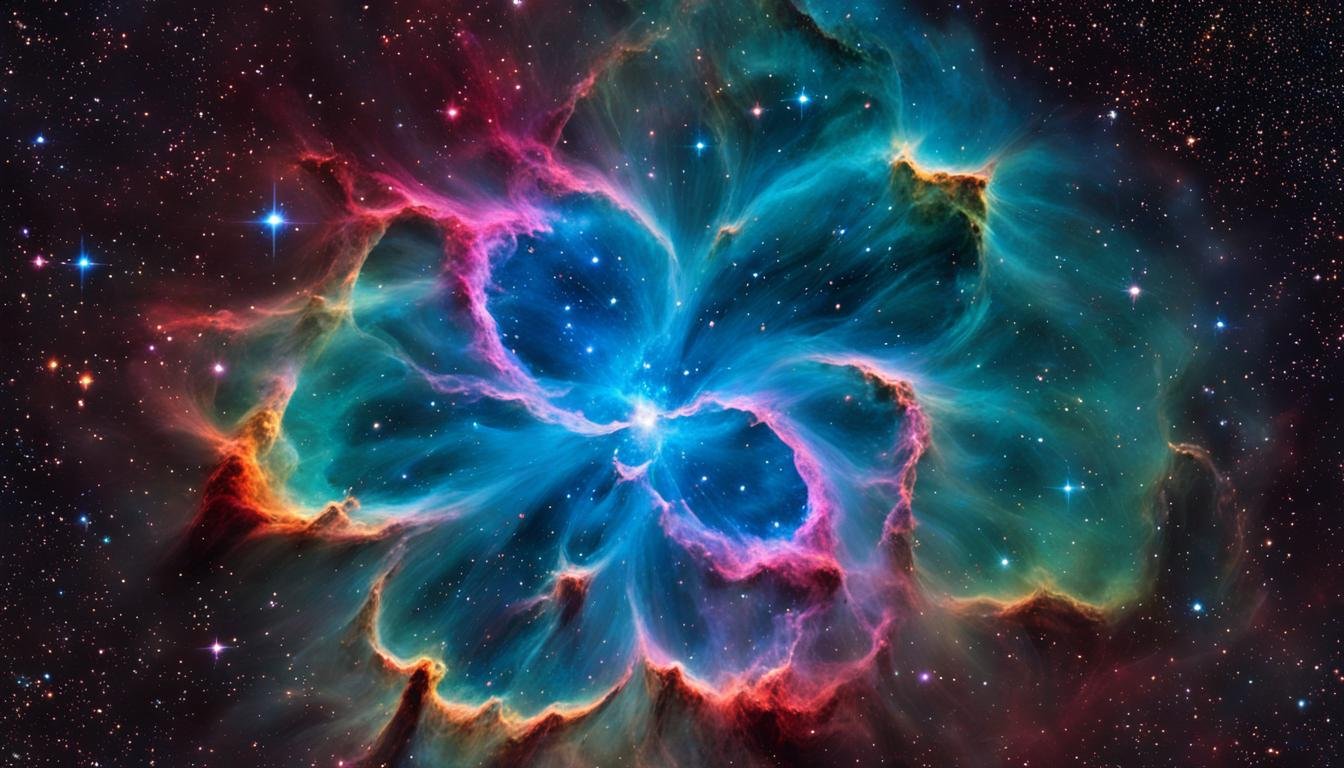Welcome to our exploration of Messier 43, also known as De Mairan’s Nebula. Located in the Orion constellation, this star-forming region is a captivating sight in the night sky. Let’s delve into the fascinating details of this celestial wonder.
Key Takeaways:
- Messier 43, or De Mairan’s Nebula, is a star-forming region within the Orion constellation.
- It is physically separate from the larger Orion Nebula and has its own distinct features and star-forming activity.
- The nebula surrounds the star NU Orionis and is associated with a rich H II region.
- Observation of Messier 43 can be done with binoculars and telescopes, revealing its elongated patch-like appearance with a bright center and dark features along its eastern border.
- It is part of the active Orion Molecular Cloud Complex, a hub of star formation in the night sky.
Discoveries and Cataloguing
Messier 43 Nebula, De Mairan’s Nebula, M43 De Mairans
Messier 43, also known as De Mairan’s Nebula, was discovered by the French scientist Jean-Jacques d’Ortous de Mairan before 1731. This fascinating nebula was catalogued by Charles Messier in 1769 and is also designated as NGC 1982 in the New General Catalogue. While it is a separate part of the larger Orion Nebula, it is physically separated by a dense lane of dust known as the northeast dark lane.
The Messier 43 Nebula is an integral part of the expansive Orion molecular cloud complex, which adds to its allure and scientific significance.
“Messier 43 is a captivating nebula that has intrigued astronomers for centuries. Its discovery by Jean-Jacques d’Ortous de Mairan and subsequent cataloguing by Charles Messier shed light on the unique features and composition of this celestial masterpiece.”
Location and Observation
Messier 43, also known as the M43 Nebula or De Mairan’s Nebula, is located in the constellation Orion, close to the famous Orion Nebula. While the Orion Nebula is a well-known stellar nursery, M43 has its own distinct features and star-forming activity.
To observe Messier 43, you can use binoculars or small telescopes. With these instruments, you will be able to catch a glimpse of the wispy smokes and dark features along the eastern border of the nebula. For a more detailed observation, larger telescopes will reveal the intricate structures within the nebula.
The ideal time to observe M43 is during the winter months when the constellation Orion dominates the evening sky. Its proximity to the Trapezium Cluster, an open cluster of massive and luminous stars formed within the Orion Nebula, further enhances the allure of observing Messier 43. This cluster provides a stunning backdrop for the nebula, making it a captivating sight.
Messier 43 spans an area of 20 x 15 arc minutes, which corresponds to a true diameter of approximately 9 light years. Its intriguing features and location within the stellar environment of Orion make it a fascinating target for both amateur and professional astronomers.
Features of Messier 43
Messier 43, located in the Orion Molecular Cloud Complex, is a star-forming region known for its distinctive features and active star-forming activity. This diffuse nebula is characterized by an open cluster of stars at its center, surrounding the variable star NU Orionis (HD 37061).
In smaller optical instruments like binoculars and small telescopes, Messier 43 appears as an elongated patch with a bright center. It showcases a unique structure that sets it apart from the neighboring Orion Nebula – a dark dust lane separates the two, giving Messier 43 its distinct appearance.
| Key Features of Messier 43 |
|---|
| Star-forming region |
| Diffuse nebula |
| Open cluster of stars |
| Nebula surrounds variable star NU Orionis (HD 37061) |
| Elongated patch shape with a bright center |
| Separated from the Orion Nebula by a dark dust lane |
| Active star-forming activity |
The youthfulness of Messier 43 is underscored by its active star-forming activity, making it an area of interest for astronomers studying stellar evolution and the processes of star birth.
Observing Messier 43 with different instruments allows astronomers to study the intricate details of its structure and gain insights into the dynamics of the region. This star-forming region within the Orion Molecular Cloud Complex provides valuable opportunities for scientific exploration and discovery.
Historical Observations and Cataloguing
Messier 43, also known as De Mairan’s Nebula, holds a significant place in astronomical history. Its exploration and cataloguing shed light on its unique characteristics and its relationship to the Orion Nebula.
“Messier 43, also known as De Mairan’s Nebula, was first observed by Jean-Jacques Dortous de Mairan in 1731.”
Jean-Jacques Dortous de Mairan, a French scientist, discovered Messier 43 in 1731. This star-forming nebula caught de Mairan’s attention due to its intriguing features and its close proximity to the Orion Nebula.
“Charles Messier catalogued it in 1769, noting its unique features and its proximity to the Orion Nebula.”
Charles Messier, an avid astronomer and cataloguer, included Messier 43 in his renowned catalog of astronomical objects in 1769. He recognized the nebula’s distinctive properties, documenting its proximity to the sizable Orion Nebula.
“William Herschel later observed the nebula and described its appearance and the changes he observed over time. Herschel’s observations confirmed that Messier 43 is not connected to the nebulosity of the Orion Nebula and is an independent object.”
William Herschel, a pioneering astronomer, further studied Messier 43 and observed its appearance and dynamic nature. His meticulous observations provided valuable insights, confirming that Messier 43 is an independent entity and not physically connected to the nebulosity of the Orion Nebula.
These historical accounts showcase the importance of Messier 43 and its contribution to our understanding of star formation and complex interstellar environments.
Table 5: Key Historical Observations and Cataloguing of Messier 43
| Year | Scientist | Significance |
|---|---|---|
| 1731 | Jean-Jacques Dortous de Mairan | Discovery of Messier 43 |
| 1769 | Charles Messier | Inclusion in Messier’s catalog |
| 18th century | William Herschel | Confirmation of independence from Orion Nebula |
The table above summarizes the key historical observations and cataloguing of Messier 43, highlighting the contributions of Jean-Jacques Dortous de Mairan, Charles Messier, and William Herschel. Their work paved the way for further exploration and understanding of this fascinating star-forming nebula.

Observing Messier 43
Messier 43, also known as the M43 Nebula or De Mairan’s Nebula, is a fascinating celestial object that can be observed with binoculars and small telescopes. It is located in the constellation Orion, close to the prominent Orion Nebula.
In the case of M43, the central star NU Orionis is easily visible, making it easier for observers to locate the nebula. When observed with small telescopes, the dark dust lane that separates M43 from the Orion Nebula becomes apparent. This feature adds to the unique appearance of M43.
The nebula itself appears as an elongated patch with a bright center, and larger instruments can reveal the presence of darker features along its eastern border. This intricate structure makes Messier 43 a captivating object to observe and study.
To get the best view of Messier 43, it is recommended to observe it from a dark location with minimal light pollution and moonlight. This will allow for a clearer and more detailed observation of the nebula and its distinct features.
Nebula Composition and Surrounding Stars
Messier 43, also known as De Mairan’s Nebula, is a fascinating celestial object composed of ionized hydrogen gas. It owes its luminous appearance to the ionizing star NU Orionis, which illuminates the surrounding nebula. Positioned within the Orion Molecular Cloud Complex, this diffuse nebula is not only a spectacle on its own but is also a part of a thriving star-forming region.
The composition of Messier 43 includes a rich H II region, a voluminous space filled with ionized hydrogen gas. This region surrounds the ionizing star and contributes to the nebula’s brilliant display. Additionally, the area surrounding Messier 43 boasts a high concentration of protostars and young stars, indicating active star formation within the region.
Astounding findings in this area of the sky reveal the presence of submillimeter continuum sources. These sources have radio continuum counterparts, suggesting the existence of outflows and early-stage star formation processes. The combination of active star-forming activity and the remarkable features within Messier 43 makes it a captivating subject of study for astronomers.
Features of Messier 43:
| Feature | Description |
|---|---|
| Luminosity | Messier 43 showcases a stunning luminosity, attributed to the ionizing star NU Orionis. |
| H II Region | The nebula is surrounded by a rich H II region, contributing to its vibrant appearance. |
| Protostars | The surrounding area hosts a high concentration of protostars, indicating ongoing star formation. |
| Submillimeter Continuum Sources | These sources with radio continuum counterparts suggest the presence of outflows and early-stage star formation processes. |
Relationship with the Orion Nebula
Messier 43, also known as De Mairan’s Nebula, is physically separate from the main body of the Orion Nebula. The two nebulae are separated by a dense dust lane known as the northeast dark lane. Although they are part of the same Orion Molecular Cloud Complex, Messier 43 has its own distinct features and star-forming activity.
The Trapezium Cluster, an open cluster of stars, is located within the Orion Nebula but is separate from the open cluster of stars within Messier 43. This separation highlights the unique characteristics and individuality of each nebula within the larger complex.

Observing the relationship between Messier 43 and the Orion Nebula provides insight into the complex processes of star formation and the intricate structure of interstellar clouds. By studying different regions within the Orion Molecular Cloud Complex, astronomers can gain a deeper understanding of the mechanisms that drive the birth and evolution of stars.
Observations with the Hubble Space Telescope
The Hubble Space Telescope has captured stunning close-up images of Messier 43, providing a detailed glimpse into its intricate structure and the presence of young stars within. These images offer a rare opportunity to witness the brilliance of the hot young stars in the region, as well as the intriguing features surrounding even younger stars that are still enveloped in protective cocoons of dust.
The observations conducted with the Hubble Space Telescope have yielded invaluable insights into the processes involved in star formation and the dynamic nature of the nebula. By studying the intricate details of Messier 43, scientists have expanded our understanding of how stars are born and how they evolve over time.
Take a look at the captivating image of Messier 43 captured by the Hubble Space Telescope:
Conclusion
Messier 43, also known as De Mairan’s Nebula, is a captivating star-forming region nestled within the Orion constellation. This nebula stands apart from the larger Orion Nebula, possessing its own distinctive characteristics and ongoing stellar birth. Embracing the star NU Orionis at its core, Messier 43 showcases a wealth of ionized hydrogen enveloping this luminous star, forming a remarkable H II region. When observed through binoculars or telescopes, the nebula reveals an elongated patch-like structure, distinguished by a radiant center and dark features adorning its eastern boundary. Situated within the dynamic Orion Molecular Cloud Complex, Messier 43 serves as a vibrant hub of celestial formation.
FAQ
What is Messier 43 also known as?
Messier 43 is also known as De Mairan’s Nebula and NGC 1982.
Who discovered Messier 43?
Messier 43 was discovered by the French scientist Jean-Jacques d’Ortous de Mairan before 1731 and catalogued by Charles Messier in 1769.
Where is Messier 43 located?
Messier 43 is located in the constellation Orion, close to the Orion Nebula.
What are the features of Messier 43?
Messier 43 is a star-forming region and a diffuse nebula with an open cluster of stars at its center.
What is the relationship between Messier 43 and the Orion Nebula?
Messier 43 is physically separate from the main body of the Orion Nebula, with a dense dust lane known as the northeast dark lane separating the two.
Can Messier 43 be observed with binoculars and telescopes?
Yes, Messier 43 can be observed with binoculars and small telescopes.
What is the composition of Messier 43?
Messier 43 is composed of ionized hydrogen gas and is associated with a rich H II region.
Are there any historical observations of Messier 43?
Yes, Messier 43 was observed by Jean-Jacques Dortous de Mairan in 1731 and catalogued by Charles Messier in 1769.
What has the Hubble Space Telescope revealed about Messier 43?
The Hubble Space Telescope has provided close-up images of Messier 43, revealing its structure and the young stars within.
What is the conclusion about Messier 43?
Messier 43 is a star-forming region located in the Orion constellation, with its own distinct features and star-forming activity.






